State Government AFRA System: Privacy and Security Assessment Report
VerifiedAdded on 2022/10/16
|8
|1861
|71
Report
AI Summary
This report provides a comprehensive privacy and security assessment of a State Government's Automated Facial Recognition Authentication (AFRA) system, focusing on its implementation for vehicle, boat, and firearms license applications and renewals. The assessment delves into the benefits of the system, such as enhanced security through biometric authentication and automated image recognition, while also addressing the inherent problems, including reliability issues, privacy law infringements, high implementation costs, and data storage concerns. The report explores the implications of using AFRA, including consistent data use, access and retention of individual data, surveillance, and anonymity, followed by ethical and privacy implications. It proposes enhancements for security and privacy, discusses police proposals, and personal implications, concluding with recommendations and a conclusion highlighting the importance of protecting biometric data privacy. The report references several sources to support its findings.
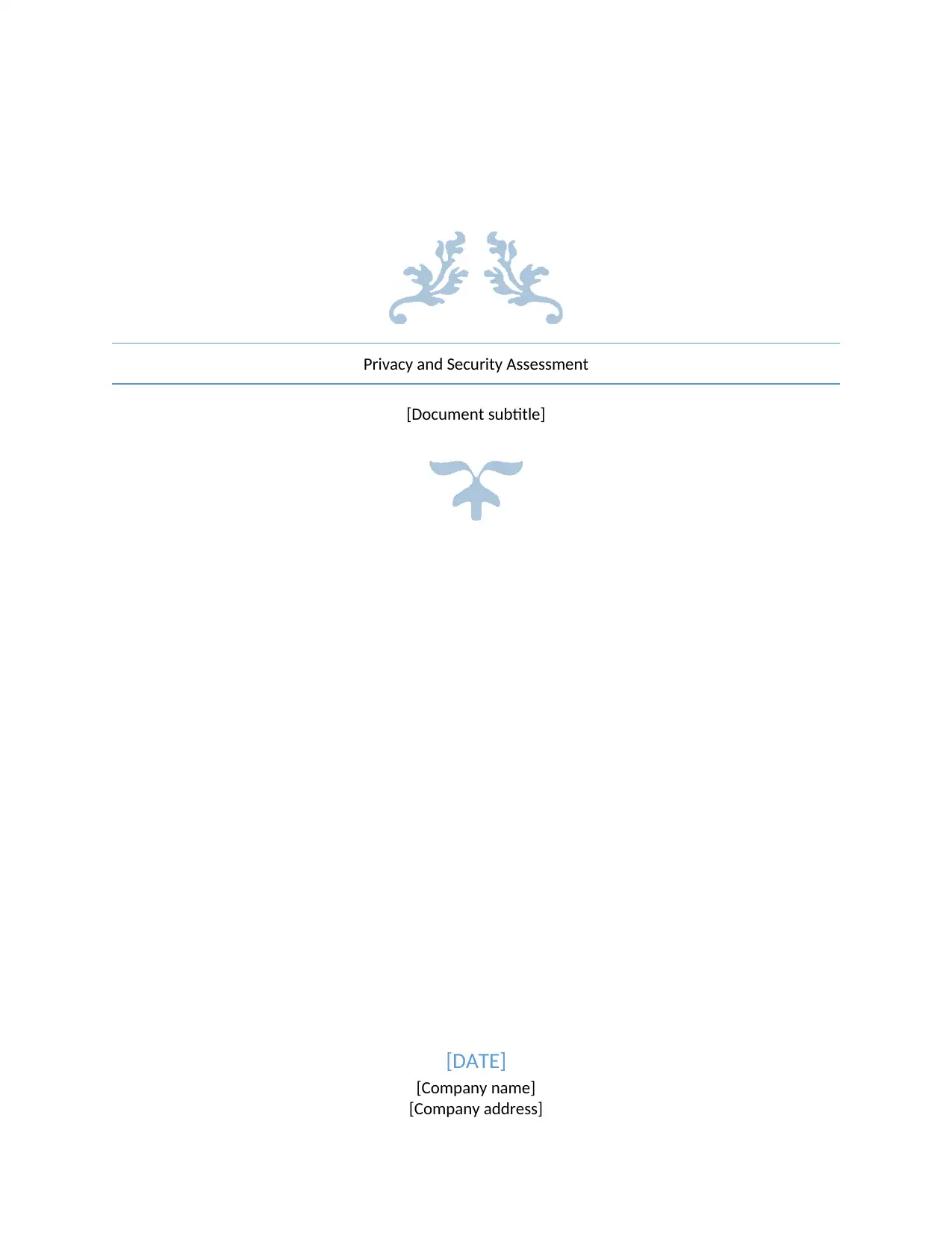
Privacy and Security Assessment
[Document subtitle]
[DATE]
[Company name]
[Company address]
[Document subtitle]
[DATE]
[Company name]
[Company address]
Paraphrase This Document
Need a fresh take? Get an instant paraphrase of this document with our AI Paraphraser
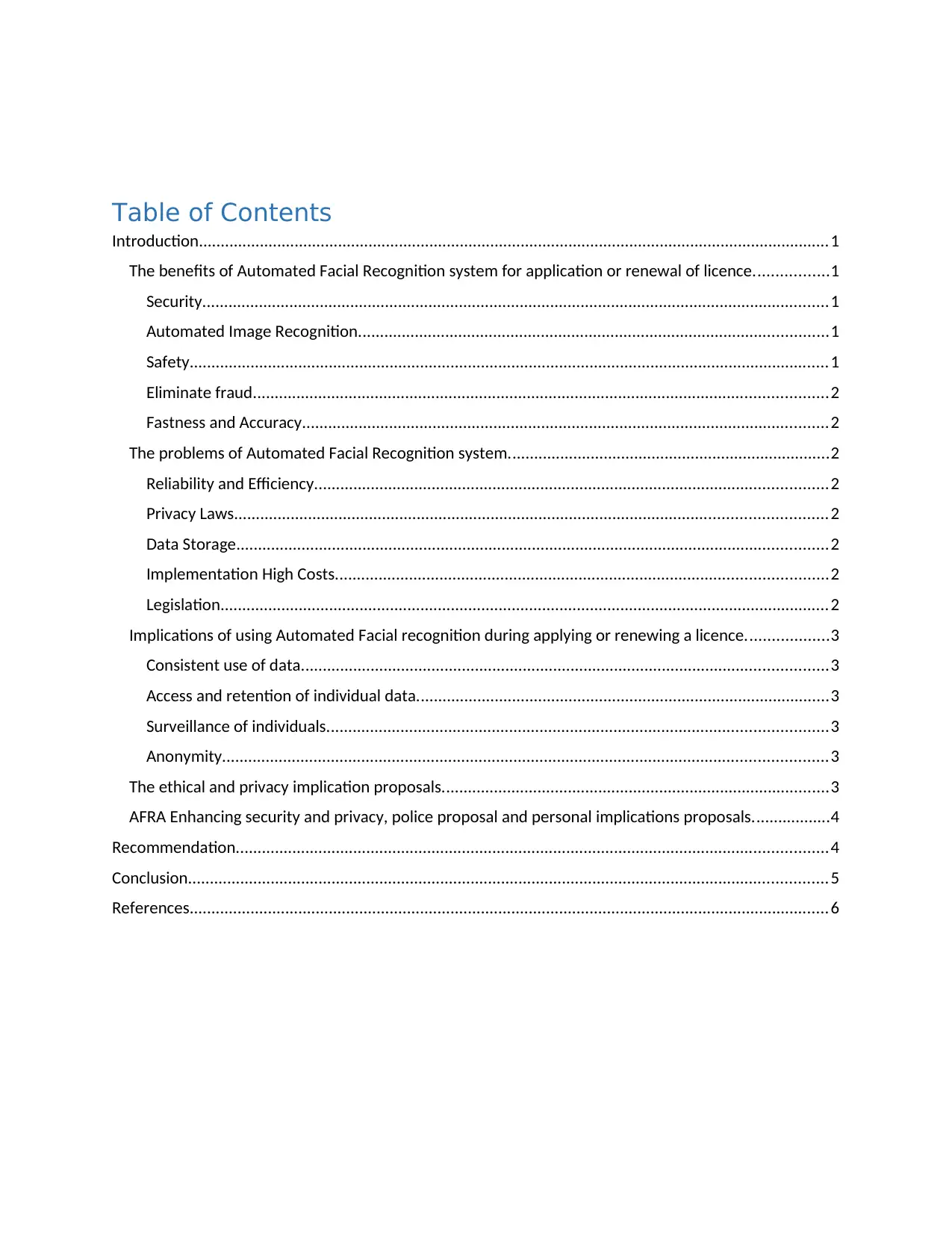
Table of Contents
Introduction.................................................................................................................................................1
The benefits of Automated Facial Recognition system for application or renewal of licence.................1
Security................................................................................................................................................1
Automated Image Recognition............................................................................................................1
Safety...................................................................................................................................................1
Eliminate fraud....................................................................................................................................2
Fastness and Accuracy.........................................................................................................................2
The problems of Automated Facial Recognition system..........................................................................2
Reliability and Efficiency......................................................................................................................2
Privacy Laws........................................................................................................................................2
Data Storage........................................................................................................................................2
Implementation High Costs.................................................................................................................2
Legislation............................................................................................................................................2
Implications of using Automated Facial recognition during applying or renewing a licence...................3
Consistent use of data.........................................................................................................................3
Access and retention of individual data...............................................................................................3
Surveillance of individuals...................................................................................................................3
Anonymity...........................................................................................................................................3
The ethical and privacy implication proposals.........................................................................................3
AFRA Enhancing security and privacy, police proposal and personal implications proposals..................4
Recommendation........................................................................................................................................4
Conclusion...................................................................................................................................................5
References...................................................................................................................................................6
Introduction.................................................................................................................................................1
The benefits of Automated Facial Recognition system for application or renewal of licence.................1
Security................................................................................................................................................1
Automated Image Recognition............................................................................................................1
Safety...................................................................................................................................................1
Eliminate fraud....................................................................................................................................2
Fastness and Accuracy.........................................................................................................................2
The problems of Automated Facial Recognition system..........................................................................2
Reliability and Efficiency......................................................................................................................2
Privacy Laws........................................................................................................................................2
Data Storage........................................................................................................................................2
Implementation High Costs.................................................................................................................2
Legislation............................................................................................................................................2
Implications of using Automated Facial recognition during applying or renewing a licence...................3
Consistent use of data.........................................................................................................................3
Access and retention of individual data...............................................................................................3
Surveillance of individuals...................................................................................................................3
Anonymity...........................................................................................................................................3
The ethical and privacy implication proposals.........................................................................................3
AFRA Enhancing security and privacy, police proposal and personal implications proposals..................4
Recommendation........................................................................................................................................4
Conclusion...................................................................................................................................................5
References...................................................................................................................................................6
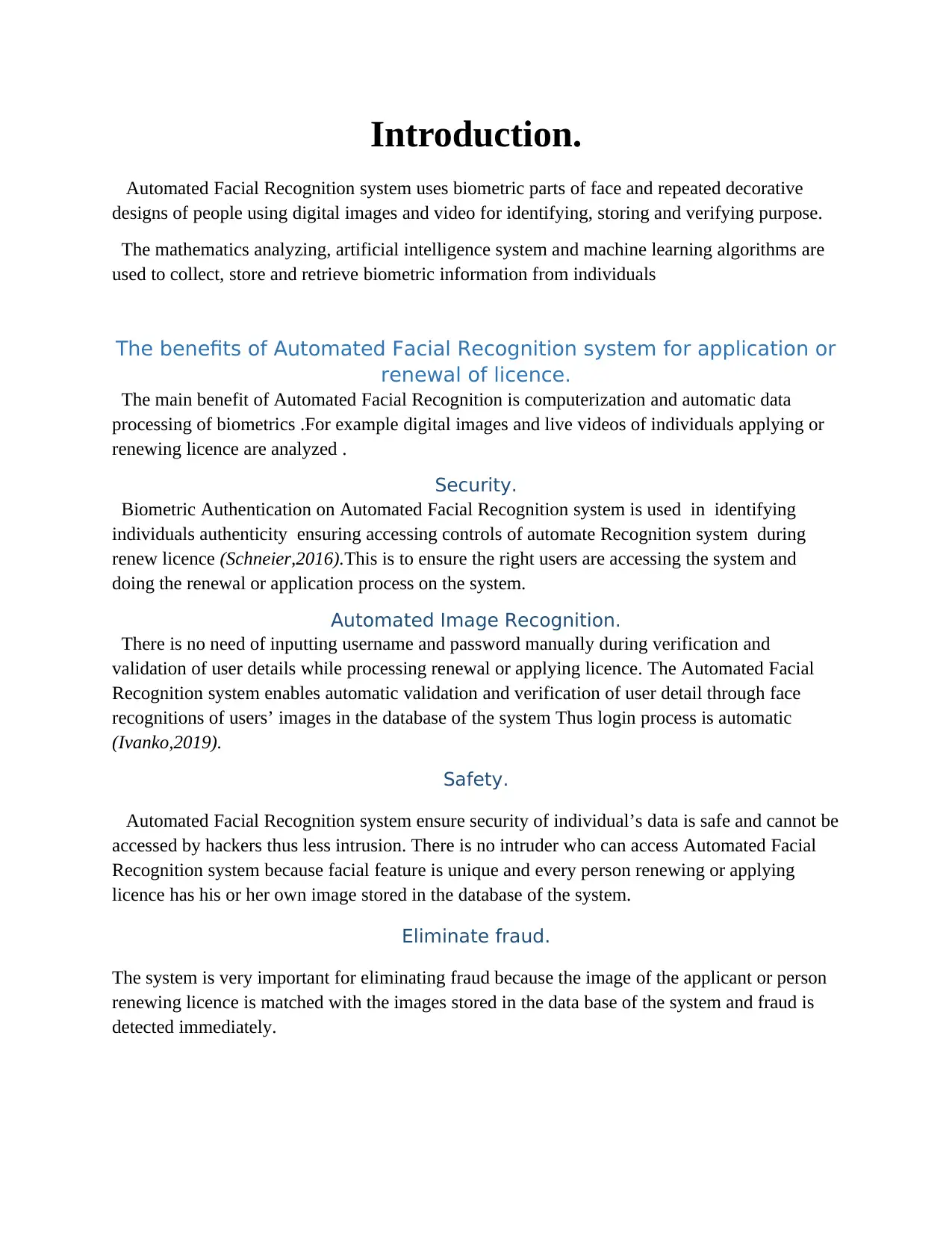
Introduction.
Automated Facial Recognition system uses biometric parts of face and repeated decorative
designs of people using digital images and video for identifying, storing and verifying purpose.
The mathematics analyzing, artificial intelligence system and machine learning algorithms are
used to collect, store and retrieve biometric information from individuals
The benefits of Automated Facial Recognition system for application or
renewal of licence.
The main benefit of Automated Facial Recognition is computerization and automatic data
processing of biometrics .For example digital images and live videos of individuals applying or
renewing licence are analyzed .
Security.
Biometric Authentication on Automated Facial Recognition system is used in identifying
individuals authenticity ensuring accessing controls of automate Recognition system during
renew licence (Schneier,2016).This is to ensure the right users are accessing the system and
doing the renewal or application process on the system.
Automated Image Recognition.
There is no need of inputting username and password manually during verification and
validation of user details while processing renewal or applying licence. The Automated Facial
Recognition system enables automatic validation and verification of user detail through face
recognitions of users’ images in the database of the system Thus login process is automatic
(Ivanko,2019).
Safety.
Automated Facial Recognition system ensure security of individual’s data is safe and cannot be
accessed by hackers thus less intrusion. There is no intruder who can access Automated Facial
Recognition system because facial feature is unique and every person renewing or applying
licence has his or her own image stored in the database of the system.
Eliminate fraud.
The system is very important for eliminating fraud because the image of the applicant or person
renewing licence is matched with the images stored in the data base of the system and fraud is
detected immediately.
Automated Facial Recognition system uses biometric parts of face and repeated decorative
designs of people using digital images and video for identifying, storing and verifying purpose.
The mathematics analyzing, artificial intelligence system and machine learning algorithms are
used to collect, store and retrieve biometric information from individuals
The benefits of Automated Facial Recognition system for application or
renewal of licence.
The main benefit of Automated Facial Recognition is computerization and automatic data
processing of biometrics .For example digital images and live videos of individuals applying or
renewing licence are analyzed .
Security.
Biometric Authentication on Automated Facial Recognition system is used in identifying
individuals authenticity ensuring accessing controls of automate Recognition system during
renew licence (Schneier,2016).This is to ensure the right users are accessing the system and
doing the renewal or application process on the system.
Automated Image Recognition.
There is no need of inputting username and password manually during verification and
validation of user details while processing renewal or applying licence. The Automated Facial
Recognition system enables automatic validation and verification of user detail through face
recognitions of users’ images in the database of the system Thus login process is automatic
(Ivanko,2019).
Safety.
Automated Facial Recognition system ensure security of individual’s data is safe and cannot be
accessed by hackers thus less intrusion. There is no intruder who can access Automated Facial
Recognition system because facial feature is unique and every person renewing or applying
licence has his or her own image stored in the database of the system.
Eliminate fraud.
The system is very important for eliminating fraud because the image of the applicant or person
renewing licence is matched with the images stored in the data base of the system and fraud is
detected immediately.
⊘ This is a preview!⊘
Do you want full access?
Subscribe today to unlock all pages.

Trusted by 1+ million students worldwide
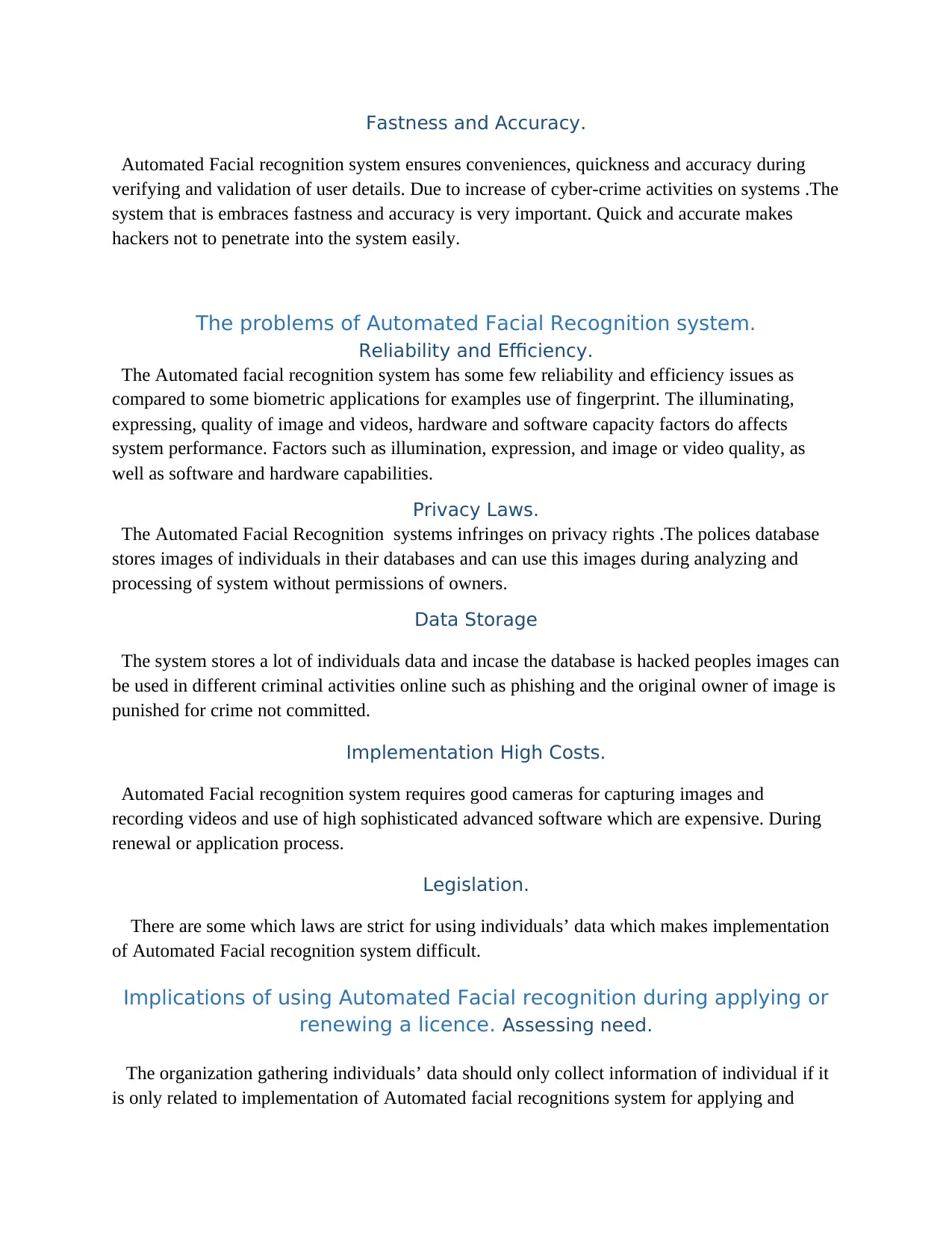
Fastness and Accuracy.
Automated Facial recognition system ensures conveniences, quickness and accuracy during
verifying and validation of user details. Due to increase of cyber-crime activities on systems .The
system that is embraces fastness and accuracy is very important. Quick and accurate makes
hackers not to penetrate into the system easily.
The problems of Automated Facial Recognition system.
Reliability and Efficiency.
The Automated facial recognition system has some few reliability and efficiency issues as
compared to some biometric applications for examples use of fingerprint. The illuminating,
expressing, quality of image and videos, hardware and software capacity factors do affects
system performance. Factors such as illumination, expression, and image or video quality, as
well as software and hardware capabilities.
Privacy Laws.
The Automated Facial Recognition systems infringes on privacy rights .The polices database
stores images of individuals in their databases and can use this images during analyzing and
processing of system without permissions of owners.
Data Storage
The system stores a lot of individuals data and incase the database is hacked peoples images can
be used in different criminal activities online such as phishing and the original owner of image is
punished for crime not committed.
Implementation High Costs.
Automated Facial recognition system requires good cameras for capturing images and
recording videos and use of high sophisticated advanced software which are expensive. During
renewal or application process.
Legislation.
There are some which laws are strict for using individuals’ data which makes implementation
of Automated Facial recognition system difficult.
Implications of using Automated Facial recognition during applying or
renewing a licence. Assessing need.
The organization gathering individuals’ data should only collect information of individual if it
is only related to implementation of Automated facial recognitions system for applying and
Automated Facial recognition system ensures conveniences, quickness and accuracy during
verifying and validation of user details. Due to increase of cyber-crime activities on systems .The
system that is embraces fastness and accuracy is very important. Quick and accurate makes
hackers not to penetrate into the system easily.
The problems of Automated Facial Recognition system.
Reliability and Efficiency.
The Automated facial recognition system has some few reliability and efficiency issues as
compared to some biometric applications for examples use of fingerprint. The illuminating,
expressing, quality of image and videos, hardware and software capacity factors do affects
system performance. Factors such as illumination, expression, and image or video quality, as
well as software and hardware capabilities.
Privacy Laws.
The Automated Facial Recognition systems infringes on privacy rights .The polices database
stores images of individuals in their databases and can use this images during analyzing and
processing of system without permissions of owners.
Data Storage
The system stores a lot of individuals data and incase the database is hacked peoples images can
be used in different criminal activities online such as phishing and the original owner of image is
punished for crime not committed.
Implementation High Costs.
Automated Facial recognition system requires good cameras for capturing images and
recording videos and use of high sophisticated advanced software which are expensive. During
renewal or application process.
Legislation.
There are some which laws are strict for using individuals’ data which makes implementation
of Automated Facial recognition system difficult.
Implications of using Automated Facial recognition during applying or
renewing a licence. Assessing need.
The organization gathering individuals’ data should only collect information of individual if it
is only related to implementation of Automated facial recognitions system for applying and
Paraphrase This Document
Need a fresh take? Get an instant paraphrase of this document with our AI Paraphraser
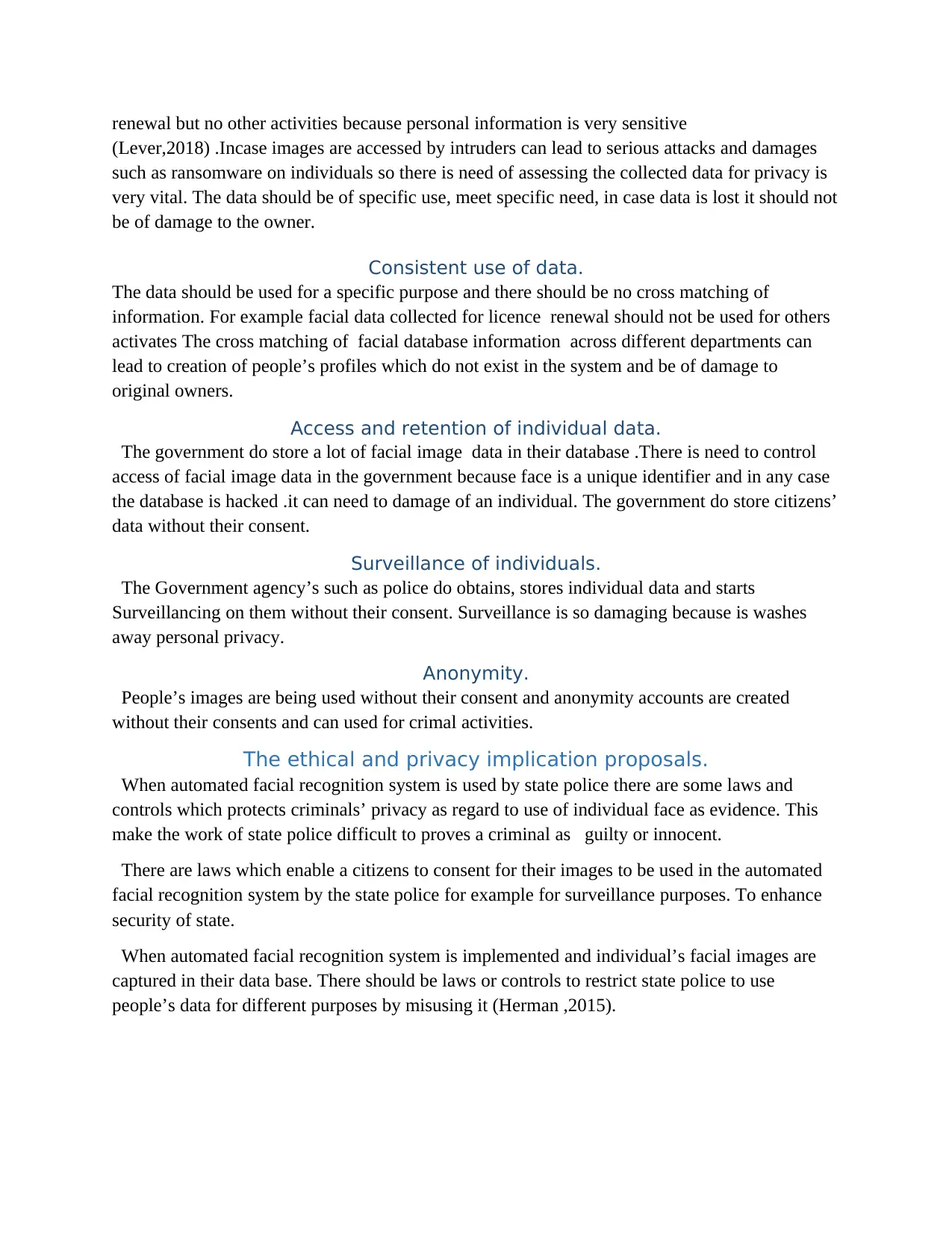
renewal but no other activities because personal information is very sensitive
(Lever,2018) .Incase images are accessed by intruders can lead to serious attacks and damages
such as ransomware on individuals so there is need of assessing the collected data for privacy is
very vital. The data should be of specific use, meet specific need, in case data is lost it should not
be of damage to the owner.
Consistent use of data.
The data should be used for a specific purpose and there should be no cross matching of
information. For example facial data collected for licence renewal should not be used for others
activates The cross matching of facial database information across different departments can
lead to creation of people’s profiles which do not exist in the system and be of damage to
original owners.
Access and retention of individual data.
The government do store a lot of facial image data in their database .There is need to control
access of facial image data in the government because face is a unique identifier and in any case
the database is hacked .it can need to damage of an individual. The government do store citizens’
data without their consent.
Surveillance of individuals.
The Government agency’s such as police do obtains, stores individual data and starts
Surveillancing on them without their consent. Surveillance is so damaging because is washes
away personal privacy.
Anonymity.
People’s images are being used without their consent and anonymity accounts are created
without their consents and can used for crimal activities.
The ethical and privacy implication proposals.
When automated facial recognition system is used by state police there are some laws and
controls which protects criminals’ privacy as regard to use of individual face as evidence. This
make the work of state police difficult to proves a criminal as guilty or innocent.
There are laws which enable a citizens to consent for their images to be used in the automated
facial recognition system by the state police for example for surveillance purposes. To enhance
security of state.
When automated facial recognition system is implemented and individual’s facial images are
captured in their data base. There should be laws or controls to restrict state police to use
people’s data for different purposes by misusing it (Herman ,2015).
(Lever,2018) .Incase images are accessed by intruders can lead to serious attacks and damages
such as ransomware on individuals so there is need of assessing the collected data for privacy is
very vital. The data should be of specific use, meet specific need, in case data is lost it should not
be of damage to the owner.
Consistent use of data.
The data should be used for a specific purpose and there should be no cross matching of
information. For example facial data collected for licence renewal should not be used for others
activates The cross matching of facial database information across different departments can
lead to creation of people’s profiles which do not exist in the system and be of damage to
original owners.
Access and retention of individual data.
The government do store a lot of facial image data in their database .There is need to control
access of facial image data in the government because face is a unique identifier and in any case
the database is hacked .it can need to damage of an individual. The government do store citizens’
data without their consent.
Surveillance of individuals.
The Government agency’s such as police do obtains, stores individual data and starts
Surveillancing on them without their consent. Surveillance is so damaging because is washes
away personal privacy.
Anonymity.
People’s images are being used without their consent and anonymity accounts are created
without their consents and can used for crimal activities.
The ethical and privacy implication proposals.
When automated facial recognition system is used by state police there are some laws and
controls which protects criminals’ privacy as regard to use of individual face as evidence. This
make the work of state police difficult to proves a criminal as guilty or innocent.
There are laws which enable a citizens to consent for their images to be used in the automated
facial recognition system by the state police for example for surveillance purposes. To enhance
security of state.
When automated facial recognition system is implemented and individual’s facial images are
captured in their data base. There should be laws or controls to restrict state police to use
people’s data for different purposes by misusing it (Herman ,2015).
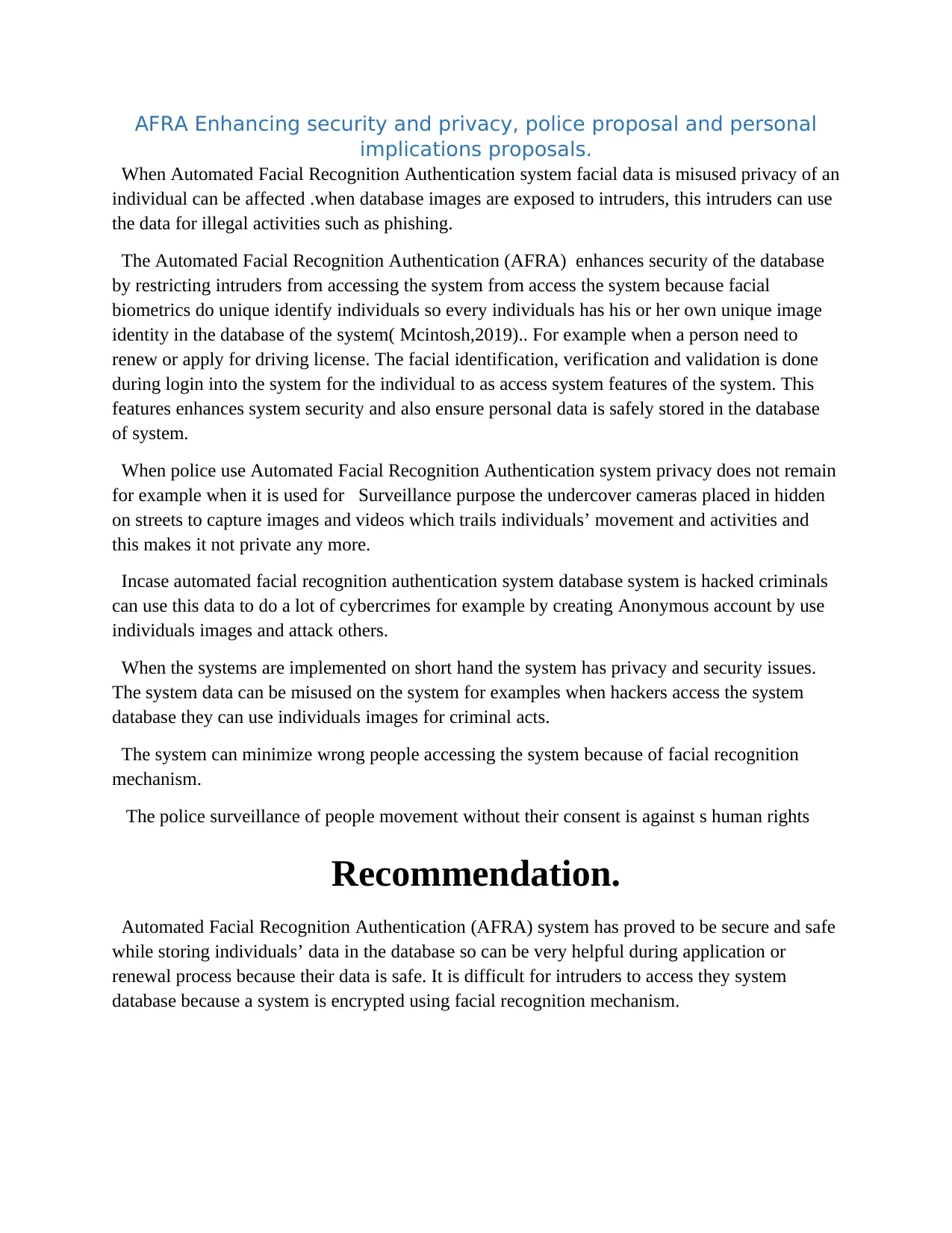
AFRA Enhancing security and privacy, police proposal and personal
implications proposals.
When Automated Facial Recognition Authentication system facial data is misused privacy of an
individual can be affected .when database images are exposed to intruders, this intruders can use
the data for illegal activities such as phishing.
The Automated Facial Recognition Authentication (AFRA) enhances security of the database
by restricting intruders from accessing the system from access the system because facial
biometrics do unique identify individuals so every individuals has his or her own unique image
identity in the database of the system( Mcintosh,2019).. For example when a person need to
renew or apply for driving license. The facial identification, verification and validation is done
during login into the system for the individual to as access system features of the system. This
features enhances system security and also ensure personal data is safely stored in the database
of system.
When police use Automated Facial Recognition Authentication system privacy does not remain
for example when it is used for Surveillance purpose the undercover cameras placed in hidden
on streets to capture images and videos which trails individuals’ movement and activities and
this makes it not private any more.
Incase automated facial recognition authentication system database system is hacked criminals
can use this data to do a lot of cybercrimes for example by creating Anonymous account by use
individuals images and attack others.
When the systems are implemented on short hand the system has privacy and security issues.
The system data can be misused on the system for examples when hackers access the system
database they can use individuals images for criminal acts.
The system can minimize wrong people accessing the system because of facial recognition
mechanism.
The police surveillance of people movement without their consent is against s human rights
Recommendation.
Automated Facial Recognition Authentication (AFRA) system has proved to be secure and safe
while storing individuals’ data in the database so can be very helpful during application or
renewal process because their data is safe. It is difficult for intruders to access they system
database because a system is encrypted using facial recognition mechanism.
implications proposals.
When Automated Facial Recognition Authentication system facial data is misused privacy of an
individual can be affected .when database images are exposed to intruders, this intruders can use
the data for illegal activities such as phishing.
The Automated Facial Recognition Authentication (AFRA) enhances security of the database
by restricting intruders from accessing the system from access the system because facial
biometrics do unique identify individuals so every individuals has his or her own unique image
identity in the database of the system( Mcintosh,2019).. For example when a person need to
renew or apply for driving license. The facial identification, verification and validation is done
during login into the system for the individual to as access system features of the system. This
features enhances system security and also ensure personal data is safely stored in the database
of system.
When police use Automated Facial Recognition Authentication system privacy does not remain
for example when it is used for Surveillance purpose the undercover cameras placed in hidden
on streets to capture images and videos which trails individuals’ movement and activities and
this makes it not private any more.
Incase automated facial recognition authentication system database system is hacked criminals
can use this data to do a lot of cybercrimes for example by creating Anonymous account by use
individuals images and attack others.
When the systems are implemented on short hand the system has privacy and security issues.
The system data can be misused on the system for examples when hackers access the system
database they can use individuals images for criminal acts.
The system can minimize wrong people accessing the system because of facial recognition
mechanism.
The police surveillance of people movement without their consent is against s human rights
Recommendation.
Automated Facial Recognition Authentication (AFRA) system has proved to be secure and safe
while storing individuals’ data in the database so can be very helpful during application or
renewal process because their data is safe. It is difficult for intruders to access they system
database because a system is encrypted using facial recognition mechanism.
⊘ This is a preview!⊘
Do you want full access?
Subscribe today to unlock all pages.

Trusted by 1+ million students worldwide
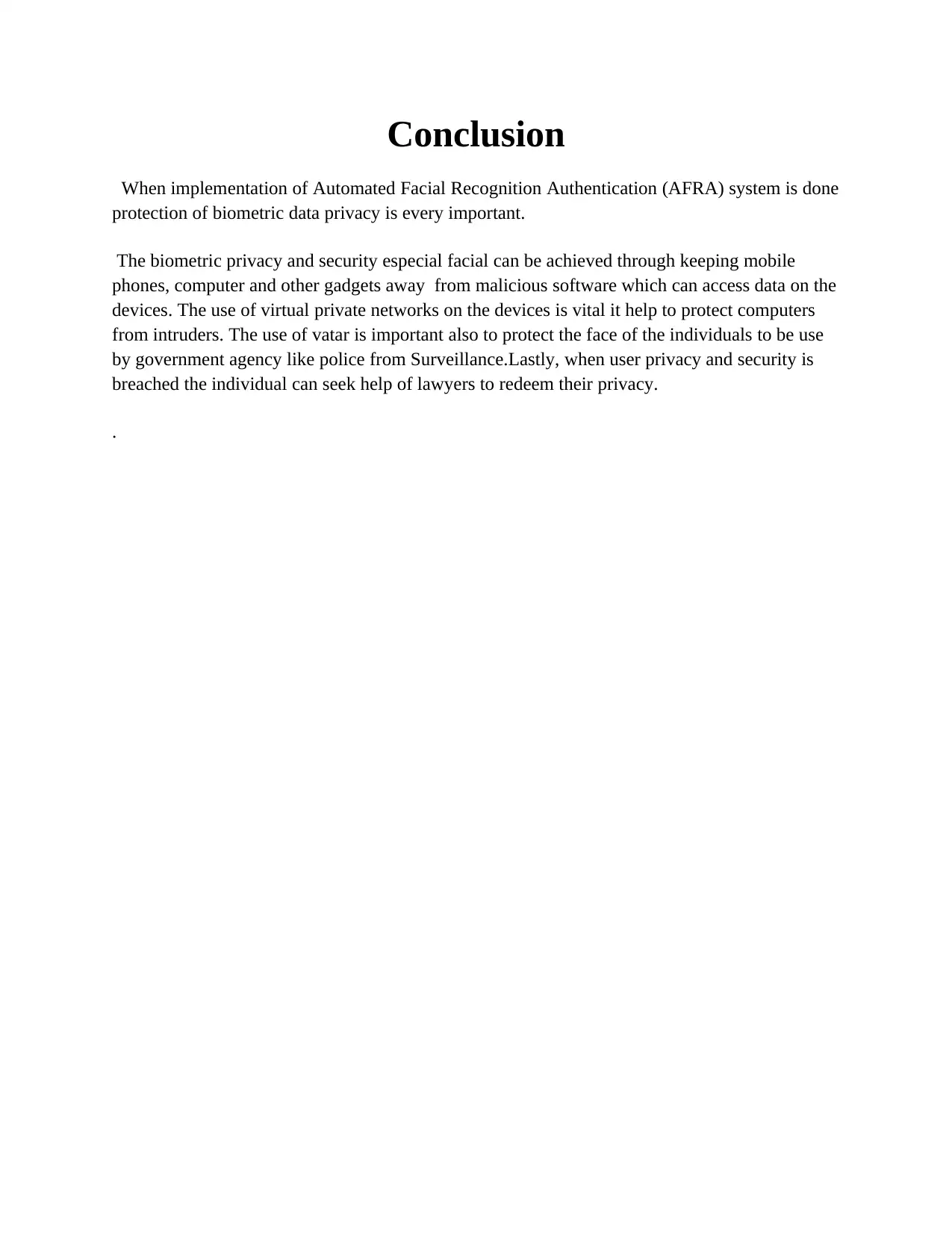
Conclusion
When implementation of Automated Facial Recognition Authentication (AFRA) system is done
protection of biometric data privacy is every important.
The biometric privacy and security especial facial can be achieved through keeping mobile
phones, computer and other gadgets away from malicious software which can access data on the
devices. The use of virtual private networks on the devices is vital it help to protect computers
from intruders. The use of vatar is important also to protect the face of the individuals to be use
by government agency like police from Surveillance.Lastly, when user privacy and security is
breached the individual can seek help of lawyers to redeem their privacy.
.
When implementation of Automated Facial Recognition Authentication (AFRA) system is done
protection of biometric data privacy is every important.
The biometric privacy and security especial facial can be achieved through keeping mobile
phones, computer and other gadgets away from malicious software which can access data on the
devices. The use of virtual private networks on the devices is vital it help to protect computers
from intruders. The use of vatar is important also to protect the face of the individuals to be use
by government agency like police from Surveillance.Lastly, when user privacy and security is
breached the individual can seek help of lawyers to redeem their privacy.
.
Paraphrase This Document
Need a fresh take? Get an instant paraphrase of this document with our AI Paraphraser
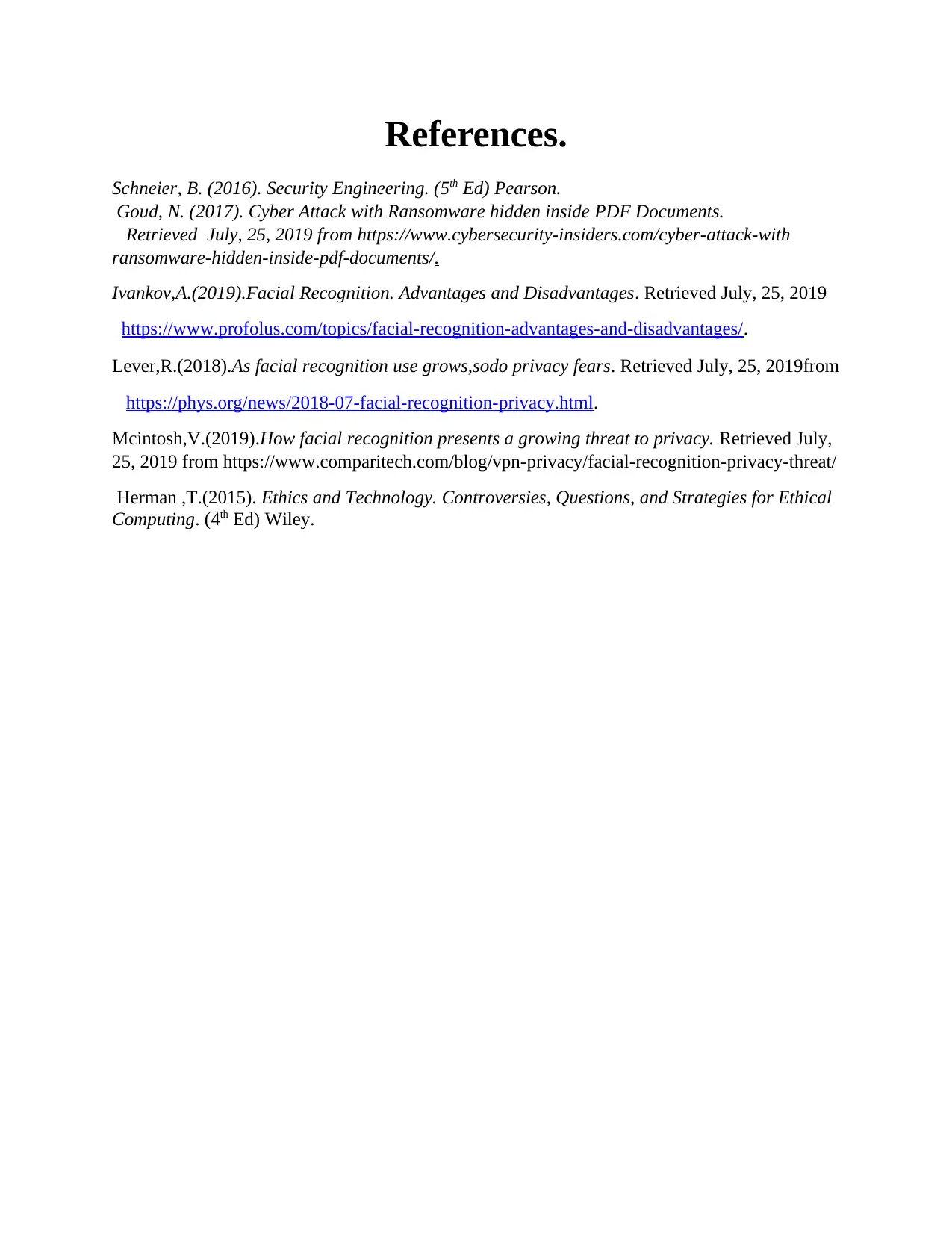
References.
Schneier, B. (2016). Security Engineering. (5th Ed) Pearson.
Goud, N. (2017). Cyber Attack with Ransomware hidden inside PDF Documents.
Retrieved July, 25, 2019 from https://www.cybersecurity-insiders.com/cyber-attack-with
ransomware-hidden-inside-pdf-documents/.
Ivankov,A.(2019).Facial Recognition. Advantages and Disadvantages. Retrieved July, 25, 2019
https://www.profolus.com/topics/facial-recognition-advantages-and-disadvantages/.
Lever,R.(2018).As facial recognition use grows,sodo privacy fears. Retrieved July, 25, 2019from
https://phys.org/news/2018-07-facial-recognition-privacy.html.
Mcintosh,V.(2019).How facial recognition presents a growing threat to privacy. Retrieved July,
25, 2019 from https://www.comparitech.com/blog/vpn-privacy/facial-recognition-privacy-threat/
Herman ,T.(2015). Ethics and Technology. Controversies, Questions, and Strategies for Ethical
Computing. (4th Ed) Wiley.
Schneier, B. (2016). Security Engineering. (5th Ed) Pearson.
Goud, N. (2017). Cyber Attack with Ransomware hidden inside PDF Documents.
Retrieved July, 25, 2019 from https://www.cybersecurity-insiders.com/cyber-attack-with
ransomware-hidden-inside-pdf-documents/.
Ivankov,A.(2019).Facial Recognition. Advantages and Disadvantages. Retrieved July, 25, 2019
https://www.profolus.com/topics/facial-recognition-advantages-and-disadvantages/.
Lever,R.(2018).As facial recognition use grows,sodo privacy fears. Retrieved July, 25, 2019from
https://phys.org/news/2018-07-facial-recognition-privacy.html.
Mcintosh,V.(2019).How facial recognition presents a growing threat to privacy. Retrieved July,
25, 2019 from https://www.comparitech.com/blog/vpn-privacy/facial-recognition-privacy-threat/
Herman ,T.(2015). Ethics and Technology. Controversies, Questions, and Strategies for Ethical
Computing. (4th Ed) Wiley.
1 out of 8
Related Documents
Your All-in-One AI-Powered Toolkit for Academic Success.
+13062052269
info@desklib.com
Available 24*7 on WhatsApp / Email
![[object Object]](/_next/static/media/star-bottom.7253800d.svg)
Unlock your academic potential
Copyright © 2020–2025 A2Z Services. All Rights Reserved. Developed and managed by ZUCOL.





